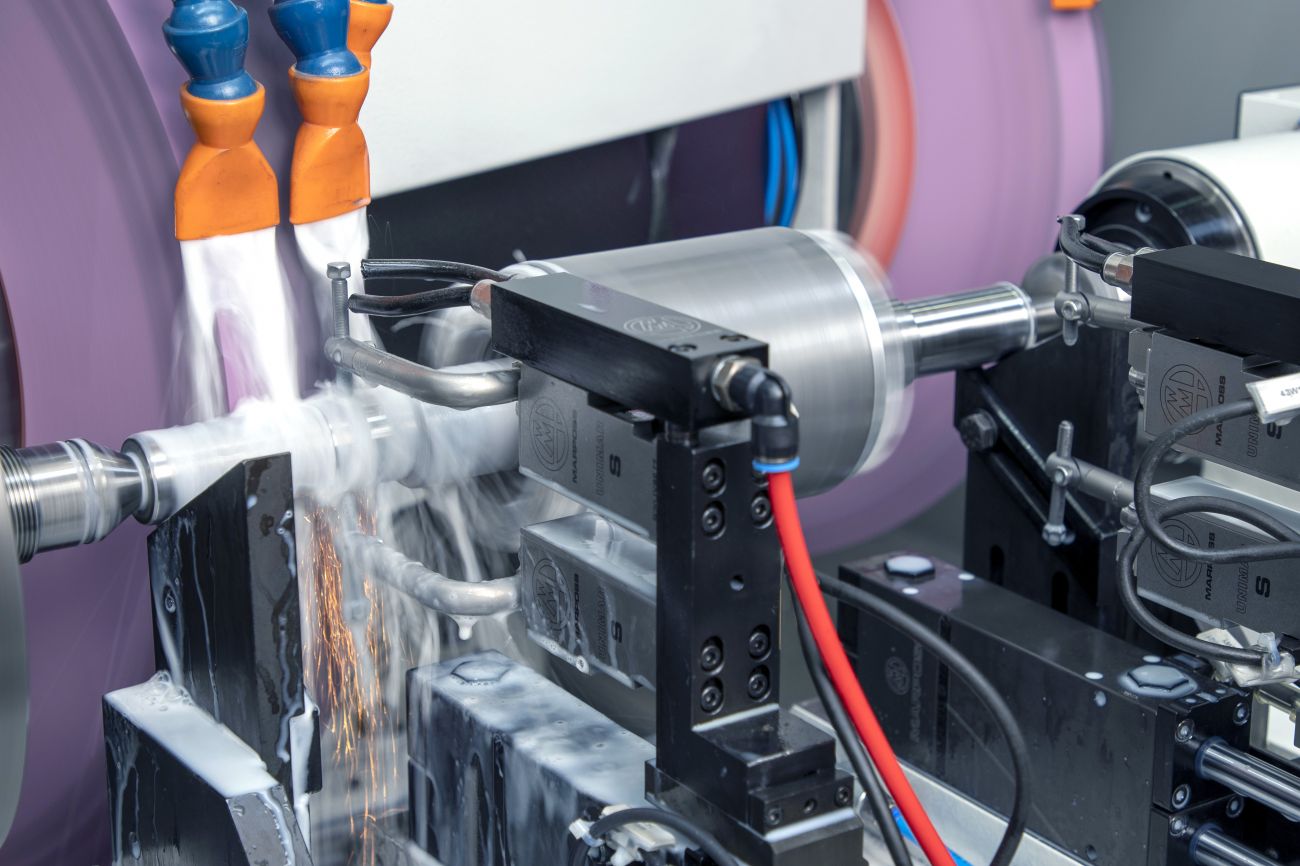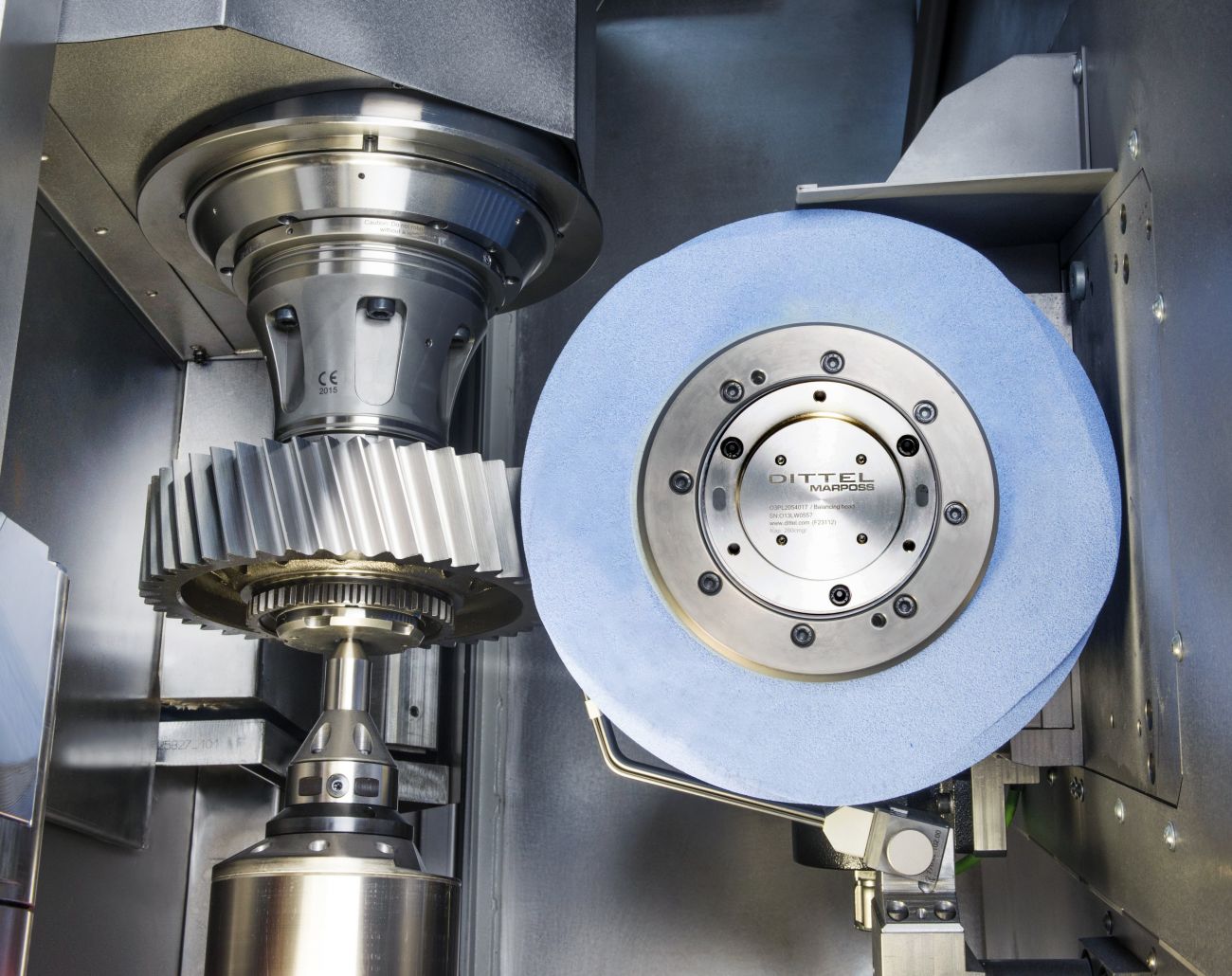FROM SMART GRINDING TO SMART FACTORIES

In the modern Manufacturing industry, optimizing production processes is essential to achieve maximum efficiency and productivity.
Marposs provides shop-floor solutions for quality control in the production environment. Marposs’ solutions include gauging equipment of mechanical components, before, during, and after the production process; monitoring solutions on machine tools; assembly and testing for many industry sectors; and automatic machines and inspection stations for production lines. Over the years, Marposs has gained enormous experience in the control of grinding processes to meet production quality requirements.
Grinding is a machining process used to remove material from a workpiece by abrasion, characterized by a specific cutting tool — the grinding wheel — that rotates at high speed and removes material from the workpiece.
Grinding technology and machines are widely used in a variety of industries, including Aerospace, Automotive, Semiconductor, EV, and Medical, among others.
There are several types of grinding machines, each designed for specific purposes. The most common are the following: cylindrical grinders, which produce internal and external cylindrical surfaces; surface grinders, which use a horizontal spindle to grind the surface of a workpiece; centerless grinders, which do not use centers to support the workpiece but have an adjustment wheel and a grinding wheel; Orbital grinders, which are able to follow the movement of eccentric parts such as a crankshaft journal; gear grinders, which use a special worm-like grinding wheel; and many others.
The surface quality and dimensional accuracy of the finished part depend on the stability and accuracy of the grinding process itself.
However, grinding can be a complex process that requires careful monitoring to ensure that it is performed efficiently and effectively. Machine monitoring is an important aspect of the grinding process that allows operators to optimize the process itself and improve product quality. It plays a crucial role in ensuring that the grinding process remains stable and reliable over time.
In this article, we will discuss the role of machine monitoring during a grinding process, paying particular attention to key parameters such as workpiece measurement, wheel imbalance compensation through vibration monitoring, and acoustic emission. We will also explore how machine monitoring is important for Industry 4.0 integration in smart factories.
Workpiece measurement is the key parameter to monitor during a process and is strictly related to the size of the workpiece.
Wheel vibration, acoustic emissions, and power monitoring keep all boundary conditions that can influence the process itself under control.
Dimensional monitoring 
In-process measurement systems can provide real-time measurement of part dimensions during the grinding process. Being able to monitor the actual size of the workpiece during the grinding process allows for the optimization of the grinding wheel feed rate and reduction of cycle time. The grinding process takes place in several phases. First, rough grinding takes place, followed by one or more fine grinding phases. Finally, there is a finishing/polishing phase. Throughout these phases, it is important to regulate the speed at which the grinding wheel approaches the final dimension of the part.
During rough grinding, it is possible to maintain a high grinding speed because the workpiece is still far from its final dimension. However, as the workpiece approaches its final dimension, the speed must be reduced accordingly. Good speed control is crucial to reduce cycle time and improve the quality of the finished part, leaving less responsibility to the operator.
Post-process measurement systems are used to measure not only the dimension but also the geometry of the finished part after the grinding process is complete. By running a post-process cycle, deviations from ideal conditions can be detected and quickly corrected. This minimizes scrap and rework and reduces production costs.
Control of wheel imbalance
Another critical aspect of the grinding process is the performance of the grinding wheel. In order to achieve a high-quality part, it is essential that the grinding wheel performs properly and removes the correct amount of stock.
When the spindle is rotating and the grinding wheel is spinning, an imbalance is always generated. This imbalance causes the grinding wheel to vibrate.
Even small imbalances in the grinding wheel or in the clamping device generate large centrifugal forces at high speeds, especially with larger grinding wheels. Forces mean vibrations. Vibrations lead to poor workpiece quality (marks, uneven surfaces, etc.), rapid wear of the spindle bearings, and rapid wear of the grinding wheel.

In this context, it is easy to understand the objective of reducing vibrations as much as possible. This is achieved by installing a system consisting of an accelerometer, which measures vibrations, and a balancing head. The balancing head is capable of moving two masses, which act as a counterweight to the imbalance.
There are several causes that can interfere with the process and cause vibrations. These include errors in the shape of the wheel, errors in the assembly of the wheel, or irregularities in the structure of the material.
By using balancing systems, any imbalance can be detected quickly and remedied promptly. This allows users to maintain a consistently high level of part quality and extend the life of their machines and tools.
Acoustic emission and power monitoring
During a grinding or straightening operation, machine components produce a noise that can be measured in the ultrasonic frequency range. To detect these frequencies, an acoustic emission sensor must be mounted in a suitable position inside the grinding machine. The acquired signal is continuously transmitted to an amplifier. The purpose of this process is to keep the machine in proper working conditions, optimize the quality of the workpiece, reduce tool wear, and reduce the risk of damage after an accident. By analyzing changes in the acoustic signals, any variation in the condition of the machine can be detected and the necessary corrective actions can be taken quickly.
Acoustic emission analysis also plays a key role in reducing cycle time by enabling a reduction in the air grinding cycle. Air grinding refers to the moment when the grinding wheel approaches the workpiece before touching it. The first contact produces an acoustic event that can be determined with micron-level accuracy.
Instead of using acoustic emission (AE) analysis, an alternative is to monitor the power consumption of the spindle. This method can be particularly useful for the GAP cycle when it is not possible to install an acoustic sensor or when there is too much background noise for the AE sensor to work properly.
|
Marposs provides shop-floor solutions for quality control in the production environment. Marposs’ solutions include gauging equipment of mechanical components, before,during, and after the production process; monitoring solutions on machine tools;assembly and testing for many industry sectors; and automatic machines and inspection stations for production lines. |
The future
Understanding how to effectively use the large amount of data generated by sensors within a machine is critical. All data from sensors can be collected and transmitted by a single general-purpose amplifier connected to the machine logic via two different channels.
The first channel involves low-level communication with the machine logic, which is typically done via a fieldbus. This allows for the optimization of the process itself.
The second communication connection uses an OPC UA channel, which makes all collected data available to other entities, such as the company’s ERP or a digital platform. This allows for the integration of entities other than grinding machines, such as shop floor equipment dedicated to testing, quality control, and process monitoring, as well as quality management software.
The primary benefit of this approach is quick and easy access to all plant information, with constant feedback on health and productivity, which can help identify areas for improvement and allow for timely action.
In addition, this approach enables additional activities to be managed more effectively, such as predicting process deviations and identifying their root causes. This represents a smarter and more efficient way to manage processes.
Cross-correlating data from different domains uncovers hidden relationships between well-known processes, revealing opportunities for improvement. Enabling companies to make more informed quality and production decisions is the future of data use.
Marposs provides shop-floor solutions for quality control in the production environment. Marposs’ solutions include gauging equipment of mechanical components, before, during, and after the production process; monitoring solutions on machine tools; assembly and testing for many industry sectors; and automatic machines and inspection stations for production lines.
|
In-process measurement systems can provide real-time measurement of part dimensions during the grinding process. Being able to monitor |
In-process measurement systems can provide real-time measurement of part dimensions during the grinding process. Being able to monitor the actual size of the workpiece during the grinding process allows for the optimization of the grinding wheel feed rate and reduction of cycle time.
Source: Marposs
Image Source: Marposs





 Facebook
Facebook.png) Twitter
Twitter Linkedin
Linkedin Subscribe
Subscribe